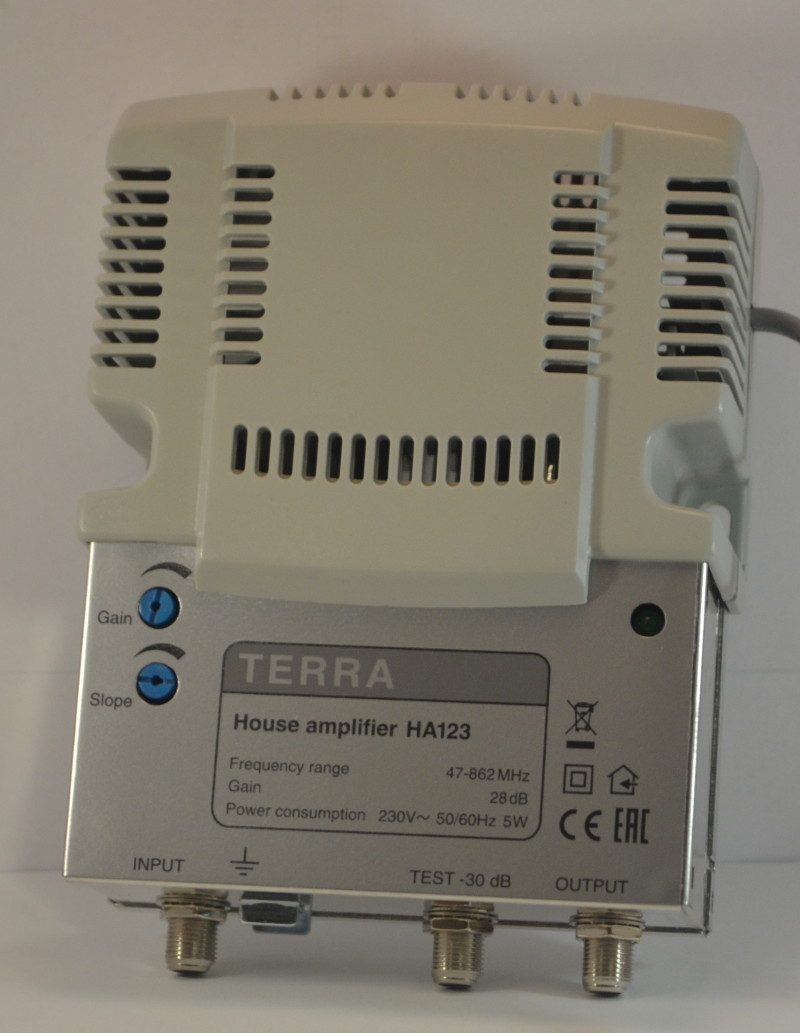Cable TV networks for the smallest. Part 6: RF Amplifiers

In this article, we consider high-frequency amplifiers of cable television on the coaxial part of the highway.
Content of a series of articles
If there is only one optical receiver on the house (or even in the whole quarter) and all the wiring to the risers is made with a coaxial cable, signal amplification at their beginning is required. Mostly Teleste devices are used in our network, so I’ll talk about them as an example, but in principle the equipment of other manufacturers is no different and the set of functionality for tuning is usually similar.
The CXE180M model has the minimum number of settings:
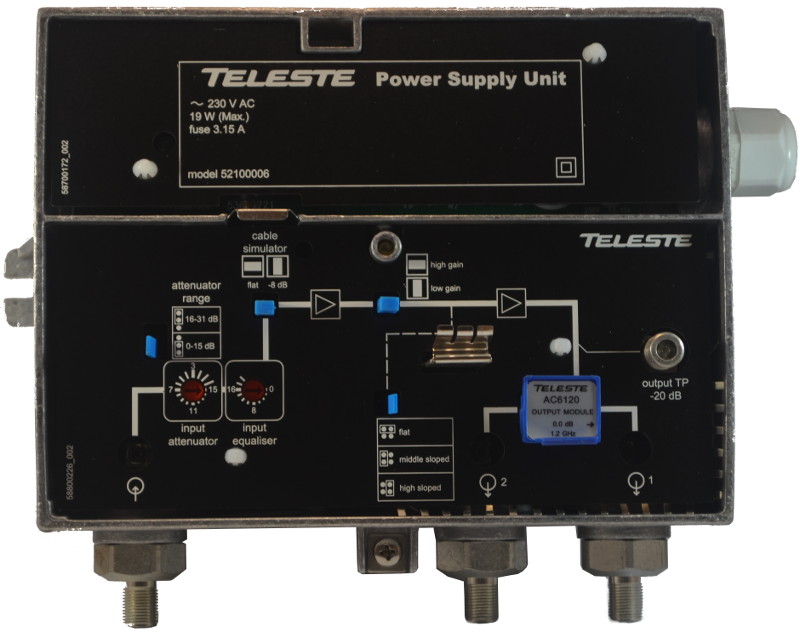
As you probably remember from the previous parts, the signal has two important quantitative parameters: this is the level and slope. It is them that can help adjust the settings of the amplifier. Let's start in order: right after the input connector there is an attenuator. It allows you to reduce the input signal by up to 31dB (when switching the blue jumper in accordance with the scheme, the twist range changes from 0-15 to 16-31dB). This is necessary if the amplifier receives a signal of more than 70 dBμV. The fact is that the amplifier stage provides a signal level increase of 40 dB, and at the output we must remove no more than 110 dBμV (at a higher level, the signal-to-noise ratio drops sharply and this figure is relevant for all broadband amplifiers and receivers with a built-in amplifier) . Thus, if 80 dBµV gets to the amplifier input, for example, then at the output it will give us 120 dBµV noise and a crumbling digit. To avoid this, you need to set the input attenuator to the 10dB blanking position.
Behind the attenuator we see an equalizer. It is necessary to eliminate the reverse tilt, if any. This is achieved by reducing the signal level in the low-frequency zone by up to 20 dB. It is worth paying attention that we cannot eliminate the reverse slope by raising the level of the upper frequencies, we can only crush the lower ones.
These two tools are enough to correct minor deviations of the signal from the norm. In case this is not so, then you can use the following:
Cable simulator, made in the form of an insert that can be placed horizontally or vertically, as the name implies, simulates the inclusion of a long section of the cable, on which the attenuation of mainly the high frequencies of the range should occur. This allows you to reduce the direct slope, if necessary, by setting 8dB in the high-frequency zone. This can be useful when installing amplifiers in cascades over short distances, for example.
After these manipulations, the signal goes through the first stage of the amplification stage, after which we see another insert, which allows us to further reduce the gain. The next jumper will again help us to push the low frequencies to get the necessary tilt. These two settings are essentially an analogue of the input attenuator and equalizer, but working with the second stage of the cascade.
At the output of the amplifier stage, we see a test tap . This is a standard threaded connector to which you can connect a measuring device or a television receiver to control the quality of the output signal. Not all devices and practically no TVs are capable of properly digesting a signal with a level of one hundred or more dBμV, so test taps on any equipment are always done with attenuation of 20-30 dB from the actual output value. This should always be kept in mind when taking measurements.
Before exiting, another insert is installed. The amplifier photo shows that the arrow depicted on it indicates only the right output. And this means that there will be no signal in the left. Such inserts are in these amplifiers "out of the box", and inside the box itself, the package contains another:

It allows you to use the second output, but inevitably introduces a signal attenuation of 4 dB.
The amplifier of the CXE180RF model at first glance has twice as many settings:
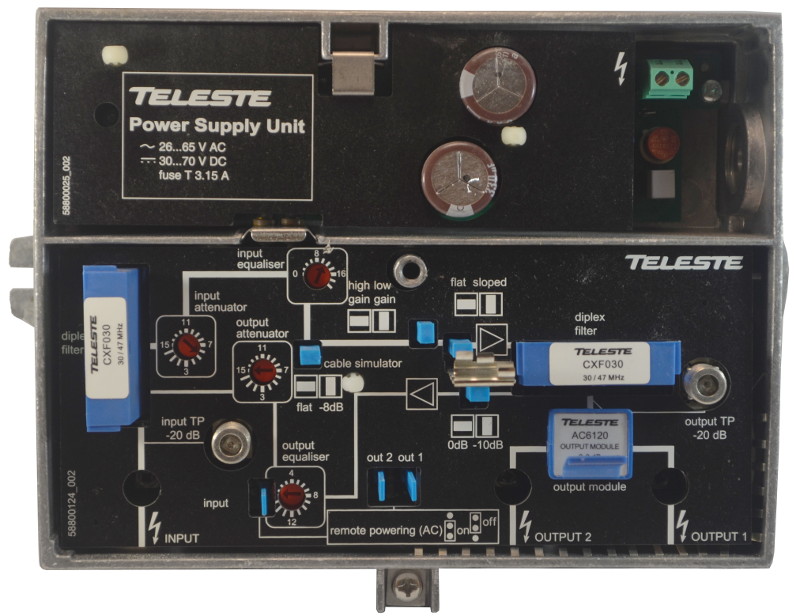
In fact, everything is not so scary: with the exception of small differences, everything is the same as in the above.
First, a test tap appeared at the input. It is needed to control the signal without disconnecting the cable from the input of the amplifier and, accordingly, without interruption of broadcasting.
Secondly, the appeared diplex filters, as well as the attenuator and equalizer of the output, are necessary to configure the DOCSIS transmission channels, so in this article I’ll just say that the filters cut off the frequencies indicated on them and this can become a problem if the signal spectrum at these frequencies, TV channels are broadcast. Fortunately, the manufacturer produces them with different values and it is not difficult to replace them if necessary.

Twists (as well as a jumper that introduces attenuation of 10 dB) affect only the return channel and are not able to change the television signal.
But the remaining three jumpers offer us to get acquainted with such technology as remote power .
When designing houses, amplifiers are often located in places where there may be problems with the supply of electricity from switchboards. In addition, each “plug-socket” pair, which also implies a circuit breaker (which can be installed in an unexpected place), represents a potential point of failure. In this regard, it is possible to power the equipment directly through a coaxial cable. Moreover, as can be seen from the marking on the cover of the power supply, it can be either alternating or direct current with a very wide voltage range. So: these three jumpers also include the possibility of the supply current flowing to the input, as well as to each of the two outputs separately, if we need to power the next amplifier in a cascade.
I already mentioned in the previous part that such a system uses special trunk couplers:
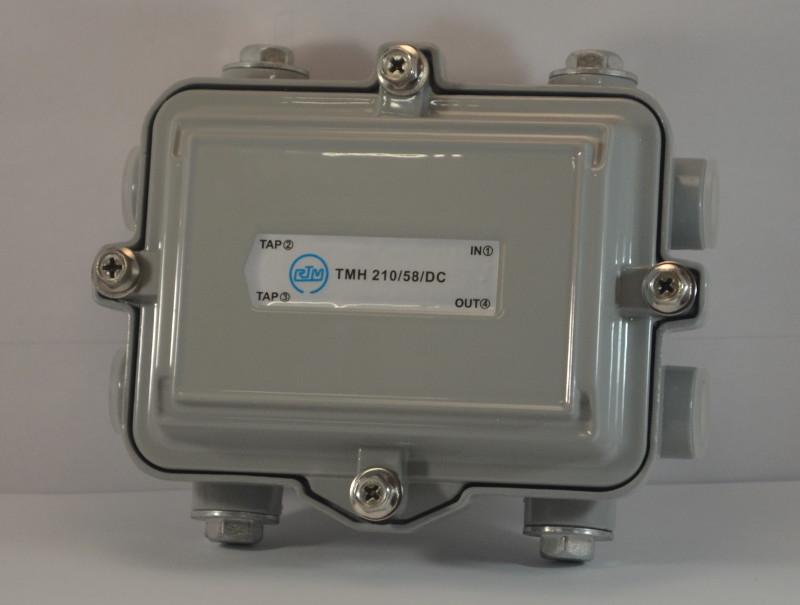
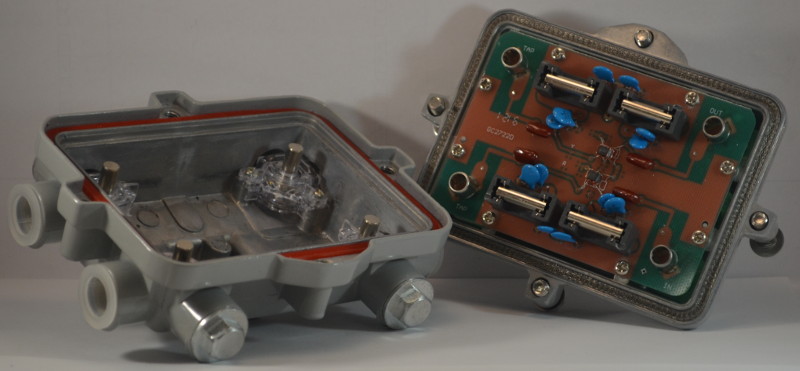
They use larger and more reliable elements, and the massive case provides heat dissipation and protection.
The power source in this case is a unit with a built-in massive transformer:
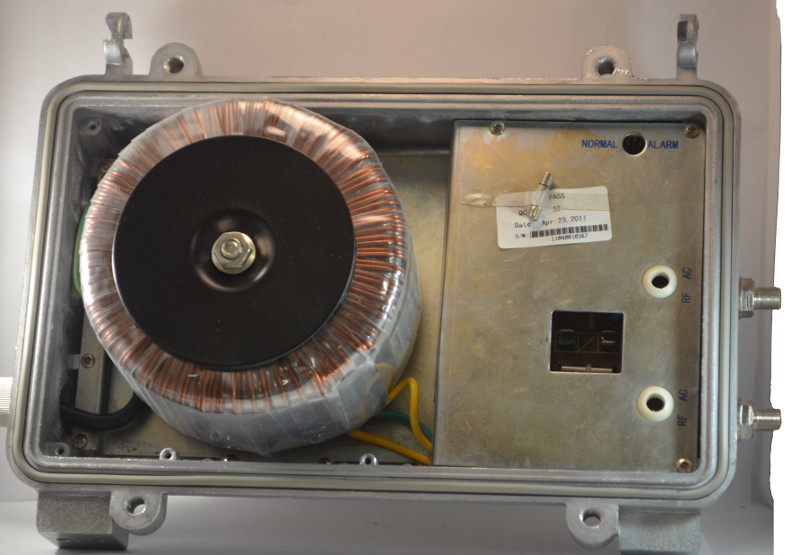
It is worth saying that with the seeming optimality of the remote power supply circuit, the amplifiers operating in this way are less likely to experience power supply crashes at home, and when they are replaced, the technical staff additionally has to search and turn off the power of the unit itself so as not to work with live cables and, thus, at the time of replacing one amplifier, the whole house remains without a signal. For the same reason, such amplifiers require a test tap at the input: otherwise, you would have to work with the cable under current.
It would be interesting to learn from colleagues how common systems with remote power are, write in the comments, if you are using, please.
If you need to connect a large number of televisions inside the apartment or office, you may encounter a lack of level after a chain of dividers. In this case, it is necessary to install an amplifier in the subscriber’s territory, for which small devices with a minimum number of settings and a lower gain level are used.
For example, this:
